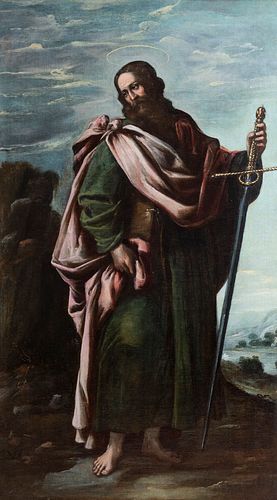Circle of VICENTE CARDUCHO (Florence, 1576 or 1978 - Madrid, 1638). "Saint Paul. Oil on canvas. Size: 134 x 76 cm; 144 x 86 cm (frame).
Lot 156
About Seller
Setdart Auction House
Carrer Aragó 346
Barcelona
Spain
Setdart Subastas was born in 2004 and is currently the first online art auction in Spain with solidity, prestige and reliability guaranteed by our more than 60,000 users. Setdart has a young, dynamic and enterprising team ready to successfully manage the purchase and sale of art works through custom...Read more
Estimate:
EUR€6,000 - EUR€8,000
$6,451.61 - $8,602.15
Absentee vs Live bid
Two ways to bid:
- Leave a max absentee bid and the platform will bid on your behalf up to your maximum bid during the live auction.
- Bid live during the auction and your bids will be submitted real-time to the auctioneer.
Bid Increments
| Price | Bid Increment |
|---|---|
| EUR€0 | EUR€10 |
| EUR€200 | EUR€25 |
| EUR€500 | EUR€50 |
| EUR€1,000 | EUR€100 |
| EUR€3,000 | EUR€200 |
| EUR€5,000 | EUR€500 |
| EUR€10,000 | EUR€1,000 |
| EUR€20,000 | EUR€2,000 |
| EUR€50,000 | EUR€5,000 |
About Auction
By Setdart Auction House
Oct 20, 2021
Set Reminder
2021-10-20 07:30:00
2021-10-20 07:30:00
America/New_York
Bidsquare
Bidsquare : OLD MASTERS
https://www.bidsquare.com/auctions/setdart-auction-house/old-masters-7700
Setdart Auction House sofia@setdart.com
Setdart Auction House sofia@setdart.com
- Lot Description
Circle of VICENTE CARDUCHO (Florence, 1576 or 1978 - Madrid, 1638). "Saint Paul. Oil on canvas. Size: 134 x 76 cm; 144 x 86 cm (frame). Saint Paul acquires in this painting a monumental canon. Represented in full body, barefoot, with classical tunic and mantle, his head appears bordered with a nimbus. He holds the martyr's back in his left hand and the Scriptures in his right. The figure is set in a landscape with a low horizon, worked with faded colours in the Flemish tradition, with plains and mountains bluish due to the effect of the distance. The low position of the horizons, which creates a narrow ground plane and ample space for the sky, and which is also in keeping with the low viewpoint that monumentalises the figures, has a certain scenographic sense, distinctly Baroque, which allows the sky to rise up like a backdrop, focusing the attention on the figure. All these are formal and stylistic solutions that have notable concomitants with the work of the painter Vicente Carducho, with his concern with colour and light, and his personal assimilation of the Flemish, Italian and Velázquez style. Vicente Carducho was a painter and treatise writer of Italian origin, although his artistic activity took place in Spain, specifically in the Madrid school. He trained as a painter of frescoes and altarpieces in which he reflected a language halfway between classicism and post-Renaissance mannerism. His first major work, the Preaching of Saint John the Baptist for the Monastery of San Francisco in Madrid, was understood to be a very daring piece for the time, a fact that indicates Carducho's importance within the complex journey through the history of art. Following the death of his brother Bartolomé Carduchó, a painter at the court of Philip II in Spain, Vicente was commissioned to decorate one of the galleries of the Royal Palace of El Pardo, producing works depicting the exploits of Achilles. He later began his career as court painter to Philip III, collaborating on important works such as the High Altar of the Monastery of Guadalupe (Cáceres) and the altarpiece of the Monastery of the Incarnation (Madrid). Until the arrival of Velázquez, he was the most influential representative of the Madrid school in painting, thus exposing his artistic conceptions and being the master of artists such as Francisco Fernández, Pedro de Obregón, Francisco Collantes, Bartolomé Román and Félix Castello. The Madrid Baroque school emerged around the court of first Philip IV and then Charles II, and developed throughout the 17th century, continuing well into the 18th. Analysts of this school have insisted on considering its development as a result of the binding power of the court; what is truly decisive is not the place of birth of the different artists, but the fact that they were educated and worked around and for a nobiliary and religious clientele based next to the royals. This allowed and encouraged a stylistic unity, even if there were the logical divergences due to the personalities of those involved. This was an awakening of the nationalist conscience as it allowed a liberation from the previous Italianate moulds and a leap from the last echoes of Mannerism to Tenebrism. This was the first step taken by the school, which gradually progressed towards a more autochthonous Baroque language linked to the political, religious and cultural conceptions of the Habsburg monarchy, before dying out with the first outbreaks of Rococo, which became apparent in the work of the last of its representatives, A. Palomino. Stylistically, the starting point was a naturalism with a notable capacity for synthesis, leading in due course to the allegorical and formal complexity characteristic of the decorative Baroque.
- Shipping Info
-
In-house shipping available. Please inquire at admin@setdart.com.
-
- Buyer's Premium



 EUR
EUR CAD
CAD AUD
AUD GBP
GBP MXN
MXN HKD
HKD CNY
CNY MYR
MYR SEK
SEK SGD
SGD CHF
CHF THB
THB







